Optimization of Cascade Small Hydropower Station Operation in the Jianhe River Basin Using a One-Dimensional Hydrodynamic Model
Abstract
:1. Introduction
2. Materials and Methods
2.1. Basic Basin Profile
2.2. Hydrodynamic Model Construction
2.2.1. Rainfall Runoff Model
- (1)
- NAM Model Introduction
- (2)
- Simulation Range
- (3)
- Input Condition
2.2.2. One-Dimensional Hydrodynamic Model
- (1)
- River Network
- (2)
- Reservoir
- (3)
- Boundary Condition
2.3. Minimum Ecological Flowmeter Method
3. Results and Discussion
3.1. Model Calibration and Validation
3.1.1. Rainfall Runoff Model Calibration and Verification
- (1)
- Model Calibration
- (2)
- Model Verification
3.1.2. One-Dimensional Hydrodynamic Model Calibration and Validation
3.2. Characteristics of Water Level Evolution and Analysis of the Key Areas of Hydropower Station Operation
3.2.1. Analysis of Water Level Evolution Characteristics
3.2.2. Analysis of the Key Areas of Hydropower Plant Scheduling
3.3. Ecological Operation of Small-River Cascade Hydropower Stations
4. Conclusions
Author Contributions
Funding
Institutional Review Board Statement
Informed Consent Statement
Data Availability Statement
Conflicts of Interest
References
- Qu, J.; Ding, X.; Sang, J.; Fenech, A.; Zhang, X. A comprehensive ecological flow calculation for a small hydropower development river: A case study. Hydrol. Process. 2022, 36, e14772. [Google Scholar] [CrossRef]
- Rahman, A.; Farrok, O.; Haque, M.M. Environmental impact of renewable energy source based electrical power plants: Solar, wind, hydroelectric, biomass, geothermal, tidal, ocean, and osmotic. Renew. Sustain. Energy Rev. 2022, 161, 112279. [Google Scholar] [CrossRef]
- Levasseur, A.; Mercier-Blais, S.; Prairie, Y.; Tremblay, A.; Turpin, C. Improving the accuracy of electricity carbon footprint: Estimation of hydroelectric reservoir greenhouse gas emissions. Renew. Sustain. Energy Rev. 2021, 136, 110433. [Google Scholar] [CrossRef]
- Yu, Z.; Zhang, J.; Zhao, J.; Peng, W.; Fu, Y.; Wang, Q.; Zhang, Y. A new method for calculating the downstream ecological flow of diversion-type small hydropower stations. Ecol. Indic. 2021, 125, 107530. [Google Scholar] [CrossRef]
- Yan, M.; Huang, W.; Zhang, T.; Ma, G.; Zhao, L. Study on dynamic flow lag time between cascade hydropower stations based on CNN-LSTM coupling model. Water Resour. Hydropower Eng. 2023, 54, 154–164. [Google Scholar]
- Zhang, W.; Sun, C. State-of-the-art Review of Hydro-Wind-Photovoltaic Hybrid Energy Systems. China Rural Water Hydropower 2022, 4, 285–293. [Google Scholar]
- Oxley, R.L.; Mays, L.W.; Murray, A. Optimization model for the sustainable water resource management of river basins. Water Resour. Manag. 2016, 30, 3247–3264. [Google Scholar] [CrossRef]
- Xiong, M.; Shao, K.; Dong, W.; Chen, H.; Zeng, C.; Que, Y.; Chen, F.; Zhu, B. Study on Fish Community Structure of the Main River Below Batang Hydropower Station and the Tributary Bachu River in the Upper Reaches of Jinsha River. Resour Environ. Yangtze Basin 2022, 31, 2481–2488. [Google Scholar]
- Lange, K.; Meier, P.; Trautwein, C.; Schmid, M.; Robinson, C.T.; Weber, C.; Brodersen, J. Basin-scale effects of small hydropower on biodiversity dynamics. Front. Ecol. Environ. 2018, 16, 397–404. [Google Scholar] [CrossRef]
- Knott, J.; Mueller, M.; Pander, J.; Geist, J. Bigger than expected: Species-and size-specific passage of fish through hydropower screens. Ecol. Eng. 2023, 188, 106883. [Google Scholar] [CrossRef]
- Mueller, M.; Knott, J.; Pander, J.; Geist, J. Experimental comparison of fish mortality and injuries at innovative and conventional small hydropower plants. J. Appl. Ecol. 2022, 59, 2360–2372. [Google Scholar] [CrossRef]
- Mohammadi, M.; Mohammadi, A.R.; Mohammadi, M.R. Optimizing Hydro Power Turbines in Order to Secure the Passage of Fishes in Khuzestan province. J. Appl. Comput. Mech. 2014, 1, 95–102. [Google Scholar]
- Ren, P.; Zhou, J.; Mo, L.; Zhang, Y. Comprehensive study on cascade hydropower stations in the lower reaches of Yalong river for power generation and ecology. Energy Sustain. Dev. 2023, 73, 236–246. [Google Scholar] [CrossRef]
- Li, Y.; Lin, J.; Qin, X.; Liu, Y.; Ren, Y.; Zhang, X. Join tecological operation optimal strategy of control and re-regulation reservoirs:A case study of Three Gorges-Gezhouba cascade reservoirs. J. Lake Sci. 2022, 34, 630–642. [Google Scholar]
- Winemiller, K.O.; McIntyre, P.B.; Castello, L.; Fluet-Chouinard, E.; Giarrizzo, T.; Nam, S.; Baird, I.G.; Darwall, W.; Lujan, N.K.; Harrison, I. Balancing hydropower and biodiversity in the Amazon, Congo, and Mekong. Science 2016, 351, 128–129. [Google Scholar] [CrossRef] [Green Version]
- Bai, T.; Xu, Y.; Sun, X.; Wei, J.; Pan, X. Study on Multi-objective Ecological Scheduling of Guanting Reservoir. Water Resour. Prot. 2022, 39, 101–108+124. [Google Scholar]
- Li, Y.; Lin, J. Calculation of minimum ecological flow in dewatering section of small hydropower stations: Taking Panxi cascade hydropower stations as an example. South-to-North Water Transf. Water Sci. Technol. 2022, 20, 536–543. [Google Scholar]
- Zhang, H.; Chang, J.; Gao, C.; Wu, H.; Wang, Y.; Lei, K.; Long, R.; Zhang, L. Management. Cascade hydropower plants operation considering comprehensive ecological water demands. Energy Conv. Manag. 2019, 180, 119–133. [Google Scholar] [CrossRef]
- Jiang, Z.; Liu, P.; Ji, C.; Zhang, H.; Chen, Y. Ecological flow considered multi-objective storage energy operation chart optimization of large-scale mixed reservoirs. J. Hydrol. 2019, 577, 123949. [Google Scholar] [CrossRef]
- Wang, M.; Zhang, J.; Guo, H.; Zhou, D.; Sun, B. Research on ecological flow discharge measures during construction period of hydropower projects. J. Xi’an Univ. Technol. 2021, 37, 53–56. [Google Scholar]
- Song, Z.; Cheng, Y.; Li, L.; Wang, W. Calculation of Ecological Flow of Diversion Hydropower Station in the Main Stream of Heihe River. Yellow River 2021, 43, 112–115. [Google Scholar]
- Wang, D.; Zou, J.; Liu, L.; Li, L.; Lai, J. Study on Ecological Regulation of Yunlong Reservoir Basin Based on Improved RVA Method. J. China Hydrol. 2023, 43, 41–46. [Google Scholar]
- Liu, S.; Chen, J.; Guan, S. Ecological Flow Calculation and Ecological Operation of Hengxi Hydropower Station Based on Improved Tennant Method. Sci. Technol. Eng. 2020, 20, 1628–1632. [Google Scholar]
- Zhang, W.; Sun, D.; Cao, X.; Yang, J.; Zhou, M.; Zhao, W. Ecological base flow determination and early warning scheme of the Datong River. J. Water Resour. Water Eng. 2023, 34, 100–109. [Google Scholar]
- Fan, S.; Yang, M.; Wang, P. Determining method of installed capacity based on river ecological flow. Yangtze River 2023, 54, 165–170. [Google Scholar]
- Chai, Z.; Yao, S. Several hotspots and progress of river ecology research. Yangtze River 2021, 52, 68–74. [Google Scholar]
- Pyo, J.; Kwon, Y.S.; Min, J.H.; Nam, G.; Song, Y.S.; Ahn, J.M.; Park, S.; Lee, J.; Cho, K.H.; Park, Y. Effect of hyperspectral image-based initial conditions on improving short-term algal simulation of hydrodynamic and water quality models. J. Environ. Manag. 2021, 294, 112988. [Google Scholar] [CrossRef]
- Doulgeris, C.; Georgiou, P.; Papadimos, D.; Papamichail, D. Ecosystem approach to water resources management using the MIKE 11 modeling system in the Strymonas River and Lake Kerkini. J. Environ. Manag. 2012, 94, 132–143. [Google Scholar] [CrossRef]
- Liang, Z.; Huang, H.; Cheng, L.; Hu, Y.; Yang, J.; Tang, T. Safety assessment for dams of the cascade reservoirs system of Lancang River in extreme situations. Stoch. Environ. Res. Risk Assess. 2017, 31, 2459–2469. [Google Scholar] [CrossRef]
- Karimi, S.; Salarijazi, M.; Ghorbani, K.; Heydari, M. Comparative assessment of environmental flow using hydrological methods of low flow indexes, Smakhtin, Tennant and flow duration curve. Acta Geophys. 2021, 69, 285–293. [Google Scholar] [CrossRef]
- Li, X.; Yin, J.; Qiu, X. Effects of Seasonal Runoff Change on Eco-environmental Water Demand of Qingshui River Channel. Bull. Soil Water Conserv. 2022, 42, 23–28+35. [Google Scholar]
- Jiang, C.; Zhou, Q.; Shen, Y.; Liu, G.; Zhang, D. Review on hydrological and hydrodynamic coupling models for flood forecasting in mountains watershed. J. Hydraul. Eng. 2021, 52, 1137–1150. [Google Scholar]
- Zhang, Y.; Zeng, K.; Wang, J.; Cai, J. Calculating Ecological Instream Flow Demand in Data-scarce Plain River:A Case Study of Tongshun River in Wuhan Reach. J. Yangtze River Sci. Res. Inst. 2020, 37, 35–40. [Google Scholar]
- Guo, Y.; Wu, X.; Qie, Z.; Ran, Y. Parameter Calibration of MIKE SHE Model Based on BP Neural Network. J. Yangtze River Sci. Res. Inst. 2019, 36, 26–30. [Google Scholar]
- Teshome, F.T.; Bayabil, H.K.; Thakural, L.; Welidehanna, F.G. Verification of the MIKE11-NAM model for simulating streamflow. J. Environ. Prot. 2020, 11, 152–167. [Google Scholar] [CrossRef] [Green Version]
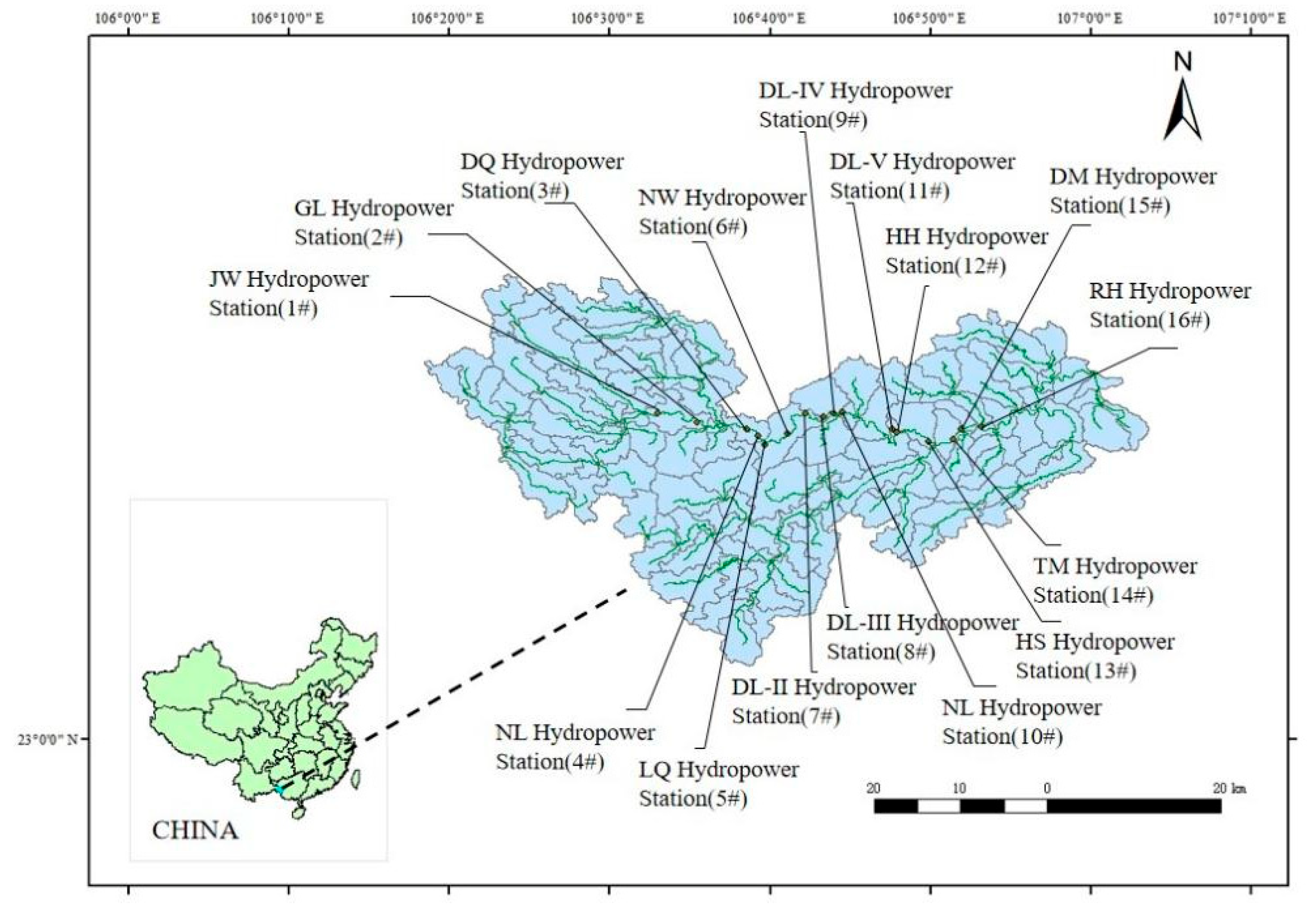
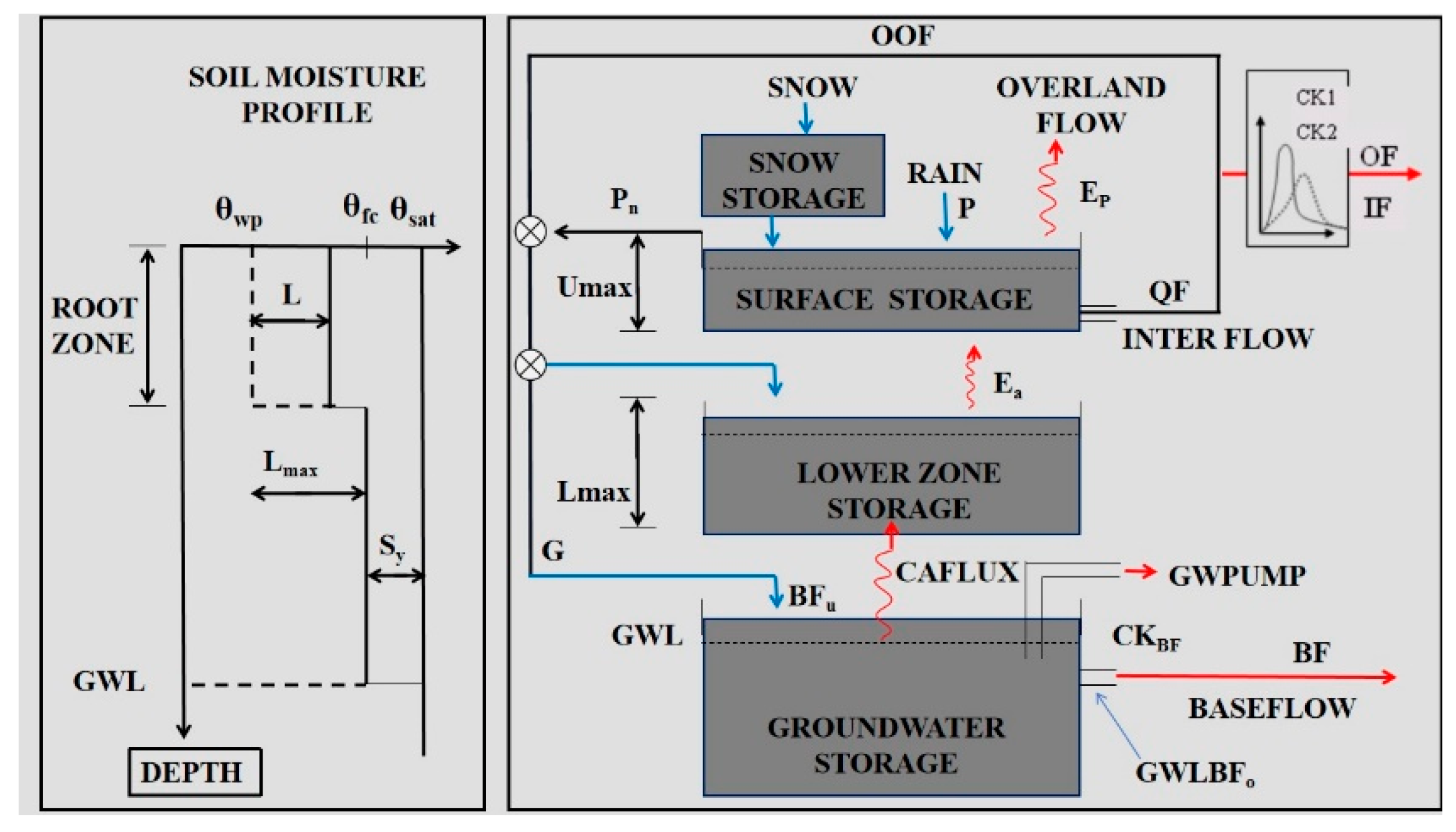
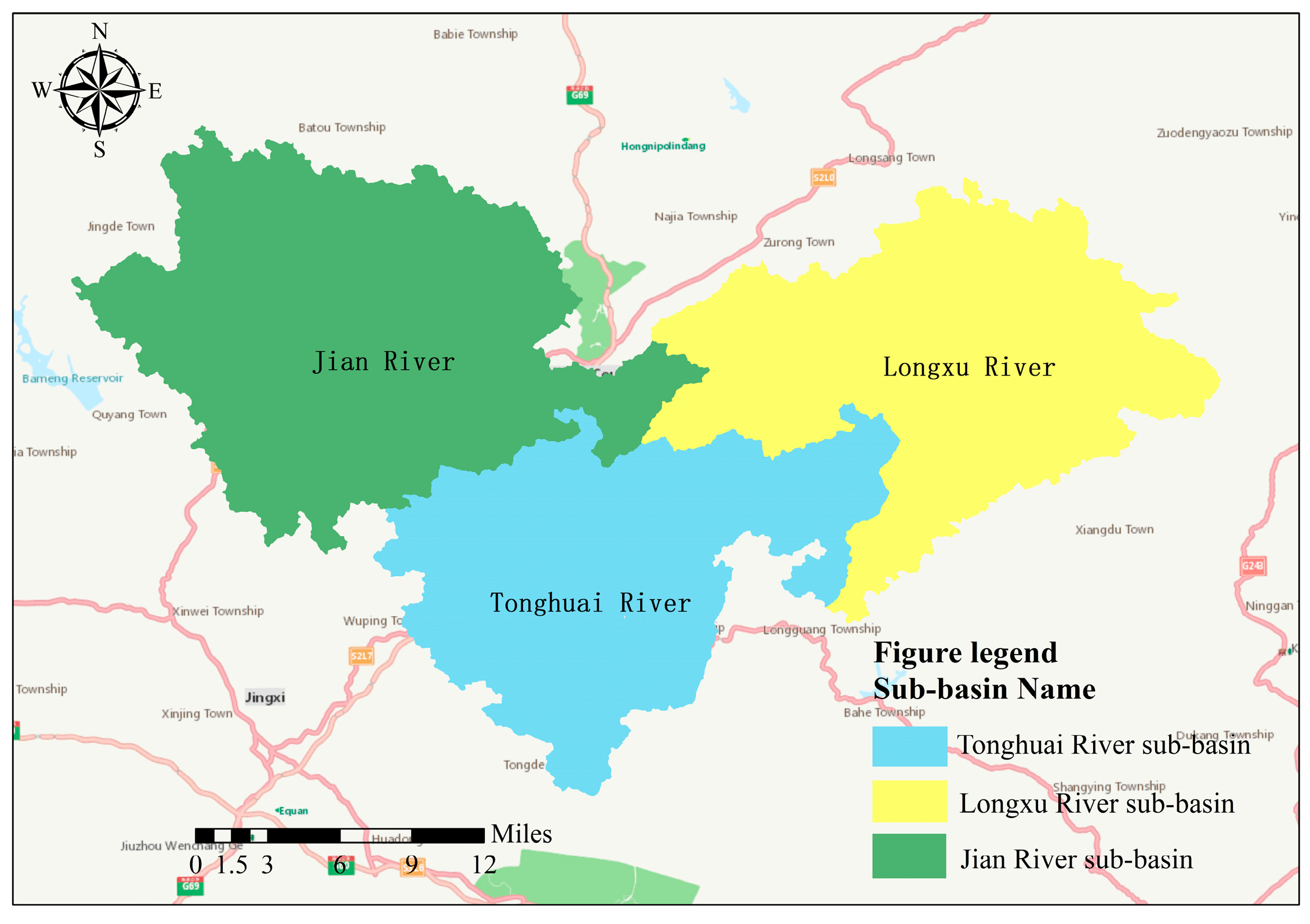


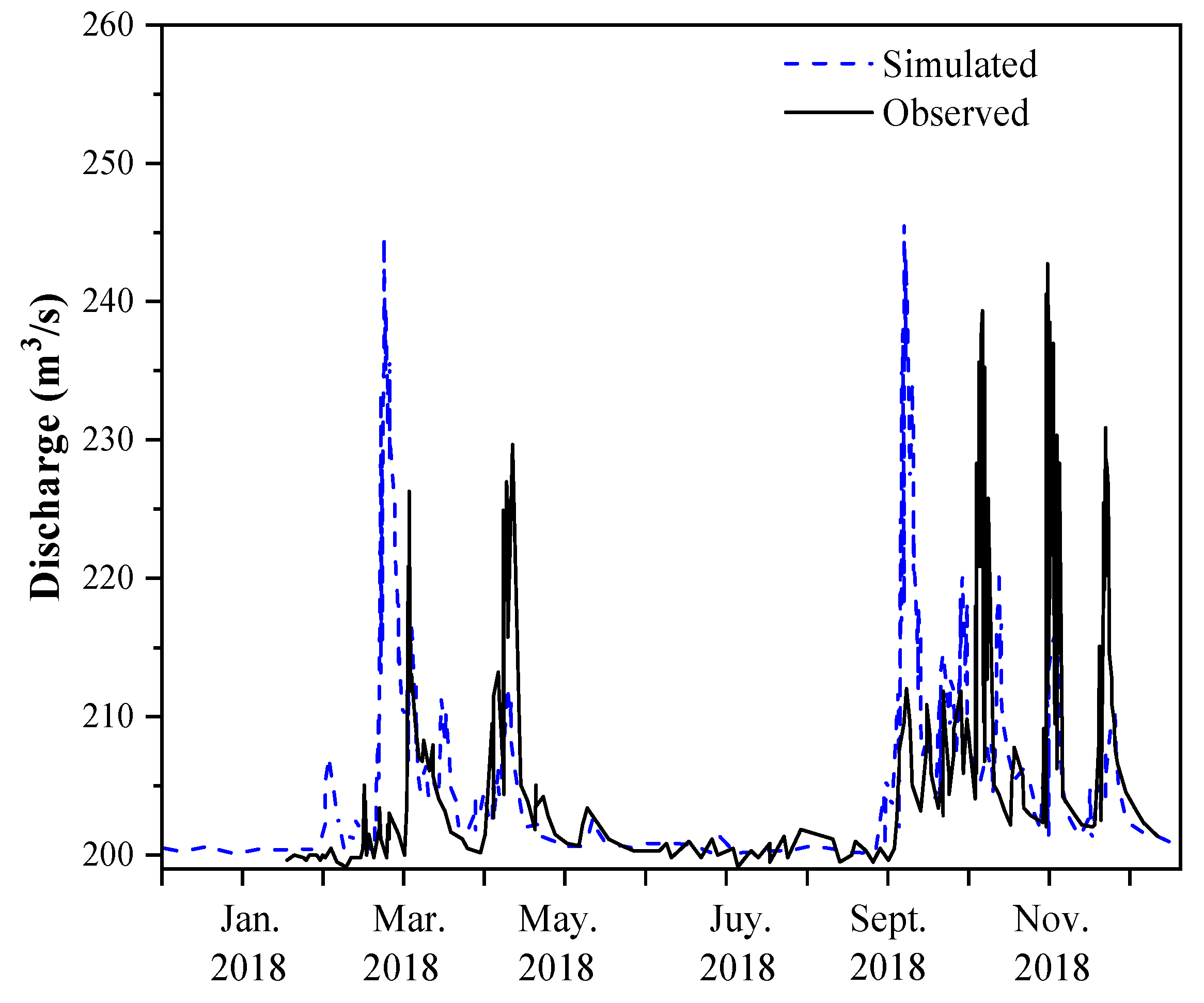
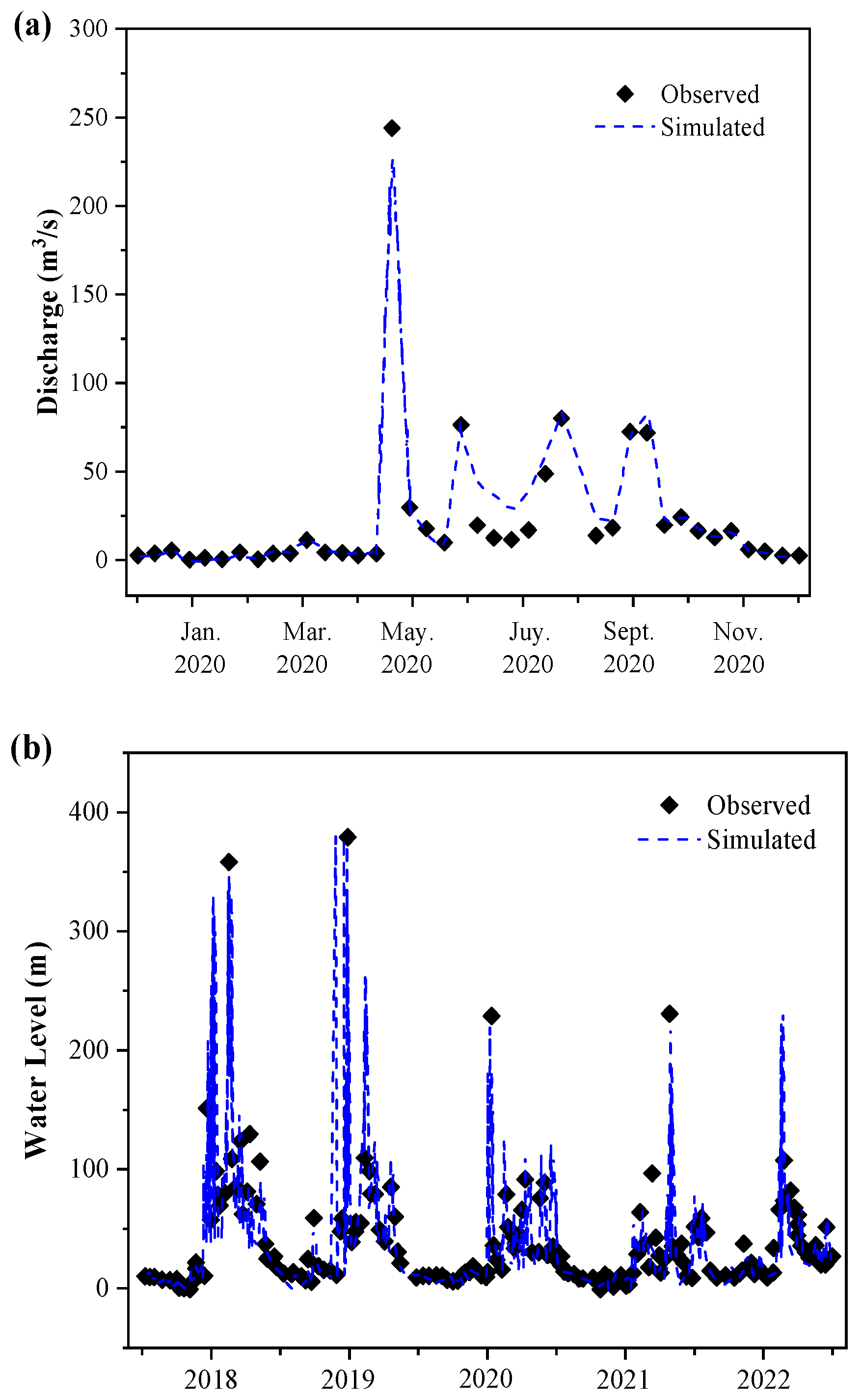

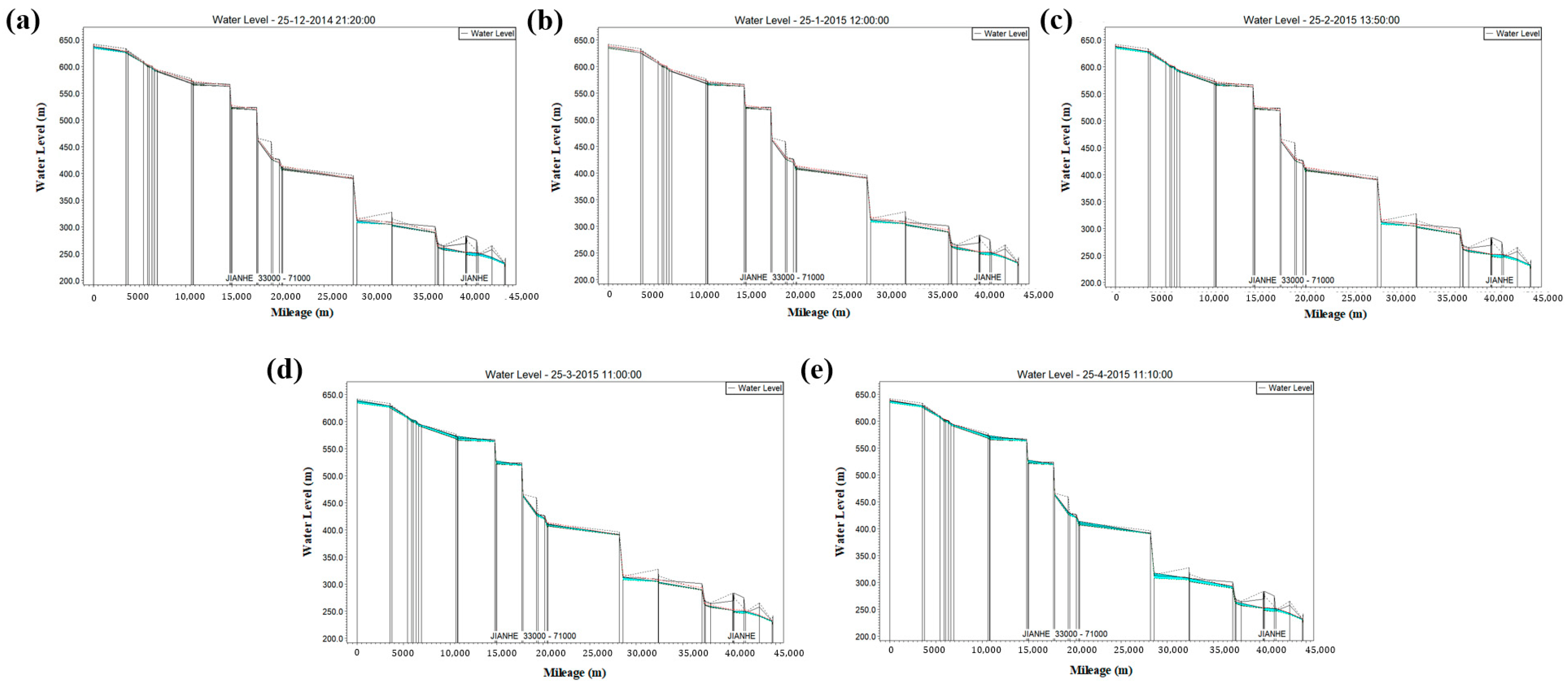
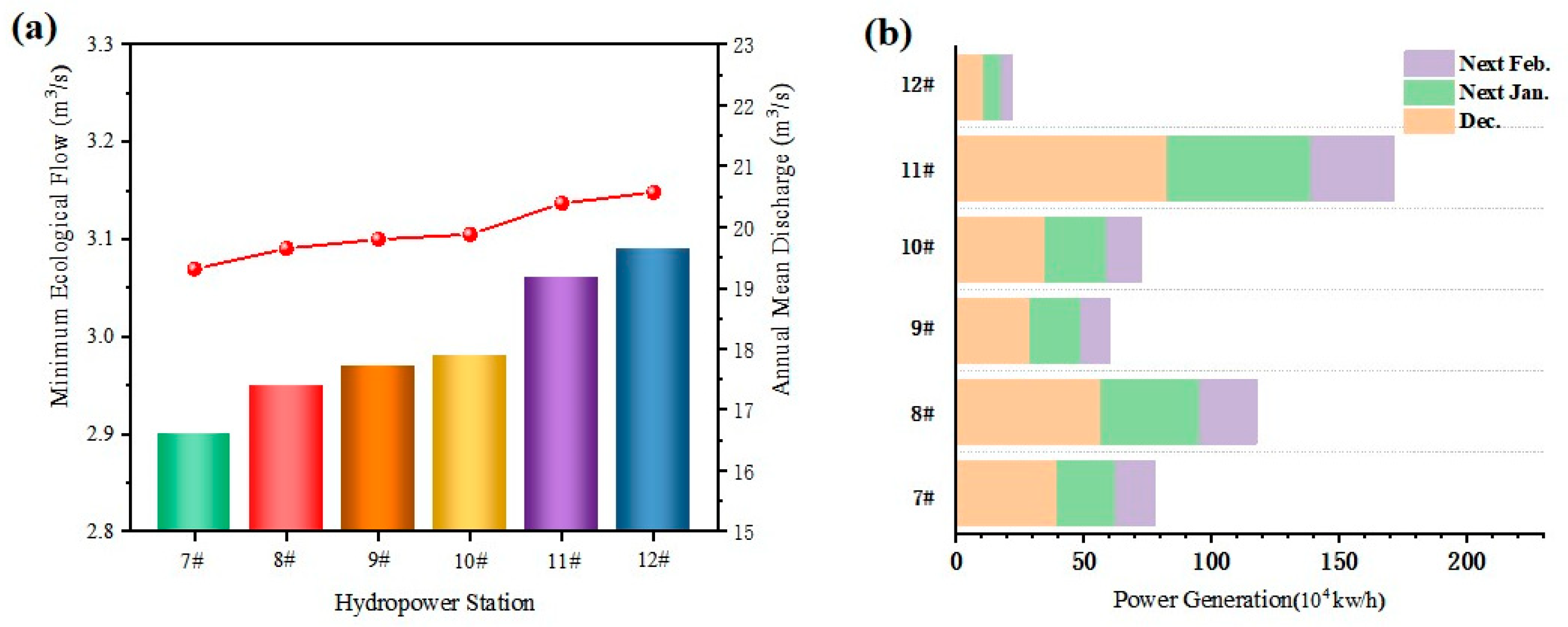
| Subbasin Name | Model Code | Area (km2) |
|---|---|---|
| Jianhe | JH | 614 |
| Tonghuaihe | THH | 463 |
| Longxuhe | LXH | 521 |
| Delimit Watershed Names | Area (km2) | River | Initial Mileage (m) | Termination Mileage (m) |
|---|---|---|---|---|
| LINQIAOHE_BASIN | 171.23 | LINQIAOHE | 0 | 21,663 |
| LINQIAOHE_BASIN | 30.00 | JIANHE | 21,910 | 31,630 |
| LINQIAOHE_CE_BASIN | 17.69 | LINQIAOHE | 19,052 | 20,013 |
| MAYIHE_BASIN | 65.40 | MAYIHE | 0 | 9000 |
| MAYIHE_BASIN | 44.26 | MAYIHE | 23,033 | 32,577 |
| MAYIHE_2_BASIN | 23.34 | MAYIHE | 9056 | 23,011 |
| JIANHE_MID02_BASIN | 11.41 | JIANHE | 31,630 | 38,419 |
| JIANHE_MID_BASIN | 275.81 | JIANHE | 38,419 | 77,700 |
| TONGHUAIHE_DOWN_BASIN | 145.97 | TONGHUAIHE | 16,035 | 39,787 |
| TONGHUAIHE_UP_BASIN | 272.10 | TONGHUAIHE | 0 | 16,054 |
| JIANHE_UP_BASIN | 208.26 | JIANHE | 0 | 22,013 |
Disclaimer/Publisher’s Note: The statements, opinions and data contained in all publications are solely those of the individual author(s) and contributor(s) and not of MDPI and/or the editor(s). MDPI and/or the editor(s) disclaim responsibility for any injury to people or property resulting from any ideas, methods, instructions or products referred to in the content. |
© 2023 by the authors. Licensee MDPI, Basel, Switzerland. This article is an open access article distributed under the terms and conditions of the Creative Commons Attribution (CC BY) license (https://creativecommons.org/licenses/by/4.0/).
Share and Cite
Li, R.; Xiao, K.; Lan, J.; Cai, L.; Huang, X. Optimization of Cascade Small Hydropower Station Operation in the Jianhe River Basin Using a One-Dimensional Hydrodynamic Model. Sustainability 2023, 15, 12138. https://doi.org/10.3390/su151612138
Li R, Xiao K, Lan J, Cai L, Huang X. Optimization of Cascade Small Hydropower Station Operation in the Jianhe River Basin Using a One-Dimensional Hydrodynamic Model. Sustainability. 2023; 15(16):12138. https://doi.org/10.3390/su151612138
Chicago/Turabian StyleLi, Ronghui, Kaibang Xiao, Jiao Lan, Liting Cai, and Xusheng Huang. 2023. "Optimization of Cascade Small Hydropower Station Operation in the Jianhe River Basin Using a One-Dimensional Hydrodynamic Model" Sustainability 15, no. 16: 12138. https://doi.org/10.3390/su151612138





